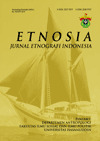Abstract
Transmigration has been applied in Indonesia as a development and population distribution strategy. Historically, the Indonesian transmigration program has a long story since the Ethical Policy until now. Furthermore, transmigration had been claimed and became the primary strategy of development in the New Order. Despite all the hope about transmigration, people considered this program failed nationally because its top-down system has caused a new problem in the destination area. However, some transmigrants have been succeeded and struggled in the new area. This paper described the bright side of what-so-called failed transmigration in Segun, Sorong, West Papua. Data are collected by multi-sited ethnography with observation and in-depth interviews of two successful Javanese families in Segun. In conclusion, this paper argues that although the program has failed nationally, each transmigrant had its strategy to survive and succeed in the new area.References
Adhiati, M.Adriana Sri; Bobsien, A. (2001). Indonesia’s Transmigration Programme – An Update. Retrieved June 30, 2020, from https://www.downtoearth-indonesia.org/old-site/ctrans.htm
Apomfires, F. (2000). Dimensi Konflik dalam Program Transmigrsi dan Strategi Pemecahannya. In Prosiding Simposium Internasional Jurnal Antropologi Indonesia. Jakarta.
Arndt, H. W. (1983). Transmigration: Achievements, Problems, Prospects. Bulletin of Indonesian Economic Studies Transmigration, 19(3), 50–73. https://doi.org/10.1080/00074918312331334429
Black, Richard; Biao, Xiang; Collyer, Michael; Heering, Godfried Liesbeth Engbersen; Markova, E. (2006). Migration and Development: Causes and Consequences. In K. Penninx, Rinus; Berger, Maria; Kraal (Ed.), The Dynamics of International Migration and Settlement in Europe (pp. 41–63). Amsterdam: Amsterdam University Press.
Düvell, F. (2007). Towards sustainable migration policies. In J. Michael (Ed.), Innovative Concepts for Alternative Migration Policies: Ten Innovative Approaches to the Challenges of Migration in the 21st Century (pp. 47–58). Amsterdam: Amsterdam University Press.
Harmadi, S. H. B., & Antarwati, E. (2014). Identifikasi Potensi Transmigran Berdasarkan Karakteristik Migran Di Indonesia. Jurnal Ketransmigrasian, 31(2), 1=16.
Jogaswara, H. (2012). MENERUSKAN HIDUP SETELAH KERUSUHAN: Ingatan Kolektif dan Identitas Etnis Madura Pasca Kekerasan Antar Etnis di Kota Sampit, Kalimantan Tengah. Universitas Indonesia.
Kementerian Desa Pembangunan Daerah Tertinggal dan Transmigrasi RI. (2015). Transmigrasi Masa Doeloe, Kini, dan Harapan Kedepan. Jakarta: Direktorat Jenderal Penyiapan Kawasan dan Pembangunan Permukiman Transmigrasi, Direktorat Bina Potensi Kawasan Transmigrasi.
Klinken, G. Van. (2007). Communal violence democratization in Indonesia: small town wars. New York: Routledge.
Kusworo, A. (2014). Lampung in the Twentieth Century: The Making of ‘Little Java.’ Canberra: ANU Press.
Lee, E. S. (1966). A Theory of Migration. Demography, 47–57.
Massey, D. S., Arango, J., Hugo, G., Kouaouci, A., Pellegrinoand, A., & Taylor, J. E. (1993). Theories of International Migration: A Review and Appraisal. Population and Development Review, 19(3), 431–466.
Oktafiani, I., & Jogaswara, H. (2019). Migrasi Orang Biak dan Identitas Orang Asli Papua di Sausapor, Papua Barat. Antropologi Indonesia, 40(1), 1–18.
Papastergiadis, N. (2000). The turbulence of migration : globalization, deterritorialization and hybridity. Cambridge: Polity Press.
Renwarin, H., Mansoben, J., & Dimara, D. (1994). Persepsi Masyarakat Irian Jaya terhadap Usaha-Usaha Pembangunan. In E. K. . Masinambow & P. Haenen (Eds.), Kebudayaan dan Pembangunan di Irian Jaya. Jakarta: LIPI-RUL.
Ricklefs, C. M. (2008). A History of Modern Indonesia. New York: Palgrave Macmillan.
Sorong, B. P. S. K. (2018). Kabupaten Sorong Dalam Angka. (B. K. Sorong, Ed.). Sorong: BPS Kabupaten Sorong.
Tirtosudarmo, R. (2013). From Colonization to Nation-state: The Political Demography in Indonesia. Jakarta: LIPI Press.
Van Hear, N., & Nyberg-Sørensen, N. (2002). The Migration-Development Nexus: Evidence and Policy Option. Geneva: International Organisation for Migration.
Winarto, Y. T., & Utami, S. P. B. (2012). Women’s Empowerment in Persisting and Changing “Family” Norms in Java. In Y. Hayami, J. Koizumi, C. Songsamphan, & R. Tosakul (Eds.), The Family In Flux in Southeast Asia: Institution, Ideology, Practice (pp. 275–294). Kyoto: Kyoto University Press and Silkworm Books.

This work is licensed under a Creative Commons Attribution-NonCommercial 4.0 International License.
Copyright (c) 2020 ETNOSIA : Jurnal Etnografi Indonesia





